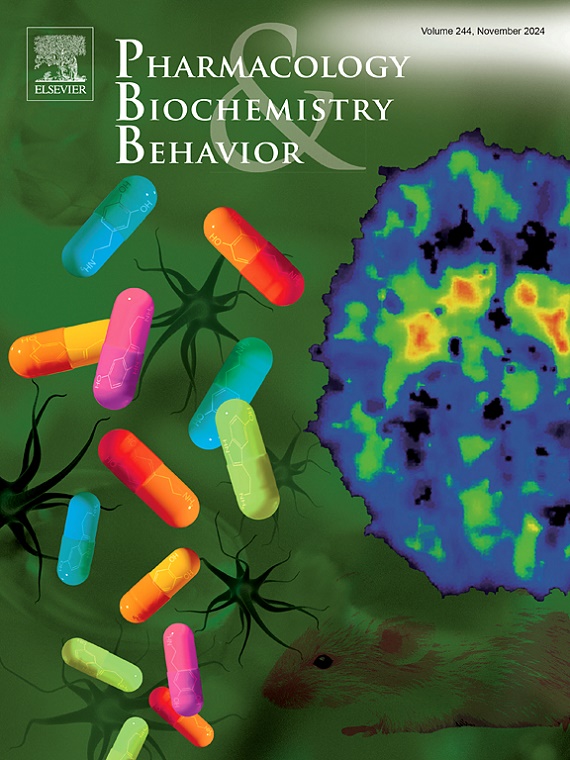甲基苯丙胺靶向单胺受体差异调节小鼠基础呼吸和芬太尼抑制呼吸
IF 3.3
3区 心理学
Q1 BEHAVIORAL SCIENCES
引用次数: 0
摘要
芬太尼仍然是致命过量的主要原因,它与甲基苯丙胺的共同使用日益引起人们的关注。我们的实验室先前证明,外消旋甲基苯丙胺可能具有呼吸刺激或抑制作用,这取决于剂量,并分别由其对映体,右甲基安非他明和左甲基安非他明决定。甲基苯丙胺的兴奋和抑制作用的对映体分离表明,它们在药理学上的差异可能被用来开发新的呼吸兴奋剂。目前尚不清楚甲基苯丙胺的单胺受体机制介导这些呼吸作用。因此,系统评价单胺受体选择性药物可以确定OIRD的治疗靶点。方法六种选择性激动剂参与甲基苯丙胺活性的单胺受体[phenylephrine (PNE;α1),可乐定(CLON;α2), skf -82958 (skf;D1),喹匹罗(QPR;d2样),8-OH- dpat (8-OH;5HT1A)和DOI (5HT2)]在成年雄性小鼠中进行检测,以确定它们对基础和芬太尼抑制分钟体积(MVb;即呼吸频率x潮气量)使用全身容积描记术。激动剂最初以三种行为活性剂量测试其对基础MVb的影响。刺激呼吸或不减少呼吸的激动剂随后与芬太尼联合试验。结果α1和D1受体激动剂PNE和SKF呈剂量依赖性增加基础MVb, α2和d2受体激动剂CLON和QPR呈剂量依赖性降低基础MVb。两种5 -羟色胺受体激动剂均未显著改变基础MVb。在芬太尼抑制条件下,SKF产生短暂但显著的MVb升高,而PNE更持久地升高MVb。有趣的是,DOI会短暂升高抑郁的MVb,而8-OH会进一步加重OIRD。结论单胺受体的选择性激活改变了基础呼吸和OIRD,其中D1和α1受体作为呼吸刺激的潜在靶点,而α2、d2样受体和5HT1A受体可能介导甲基苯丙胺对OIRD的加重。本文章由计算机程序翻译,如有差异,请以英文原文为准。
Monoamine receptors targeted by methamphetamine differentially modulate basal and fentanyl-depressed respiration in mice
Rationale
Fentanyl remains the primary cause of fatal overdoses, and its co-use with methamphetamine is a growing concern. Our lab previously demonstrated that racemic methamphetamine could have either respiratory stimulant or depressant effects depending on dose and separately determined by its enantiomers, dextromethamphetamine, and levomethamphetamine, respectively. Enantiomeric separation of methamphetamine's stimulant and depressant effects indicates that differences in their pharmacology might be exploited to develop novel respiratory stimulants. It is presently unknown which of methamphetamine's monoamine receptor mechanisms mediate these respiratory effects. Thus, systematic evaluation of monoamine receptor-selective agents may identify treatment targets for OIRD.
Methods
Six selective agonists at monoamine receptors involved in methamphetamine's activity [phenylephrine (PNE; α1), clonidine (CLON; α2), SKF-82958 (SKF; D1), quinpirole (QPR; D2-like), 8-OH-DPAT (8-OH; 5HT1A), and DOI (5HT2)] were tested in adult male mice to determine their effects on basal and fentanyl-depressed minute volume (MVb; i.e., respiratory frequency x tidal volume) using whole-body plethysmography. Agonists were initially tested at three behaviorally active doses for their effects on basal MVb. Agonists that stimulated respiration or did not decrease respiration were then tested in combination with fentanyl.
Results
The α1 and D1 agonists PNE and SKF dose-dependently increased basal MVb while the α2 and D2-like agonists CLON and QPR depressed basal MVb. Neither serotonin receptor agonist significantly altered basal MVb. Under fentanyl-depressed conditions, SKF produced transient but significant increases in MVb, while PNE more persistently elevated it. Interestingly, DOI transiently elevated depressed MVb, while 8-OH further exacerbated OIRD.
Conclusions
Selective activation of monoamine receptors alters basal respiration and OIRD, with D1 and α1 receptors representing potential targets as respiratory stimulants, whereas α2, D2-like, and 5HT1A receptors may mediate the exacerbation of OIRD by methamphetamine.
求助全文
通过发布文献求助,成功后即可免费获取论文全文。
去求助
来源期刊
CiteScore
6.40
自引率
2.80%
发文量
122
审稿时长
38 days
期刊介绍:
Pharmacology Biochemistry & Behavior publishes original reports in the areas of pharmacology and biochemistry in which the primary emphasis and theoretical context are behavioral. Contributions may involve clinical, preclinical, or basic research. Purely biochemical or toxicology studies will not be published. Papers describing the behavioral effects of novel drugs in models of psychiatric, neurological and cognitive disorders, and central pain must include a positive control unless the paper is on a disease where such a drug is not available yet. Papers focusing on physiological processes (e.g., peripheral pain mechanisms, body temperature regulation, seizure activity) are not accepted as we would like to retain the focus of Pharmacology Biochemistry & Behavior on behavior and its interaction with the biochemistry and neurochemistry of the central nervous system. Papers describing the effects of plant materials are generally not considered, unless the active ingredients are studied, the extraction method is well described, the doses tested are known, and clear and definite experimental evidence on the mechanism of action of the active ingredients is provided.

 求助内容:
求助内容: 应助结果提醒方式:
应助结果提醒方式:


